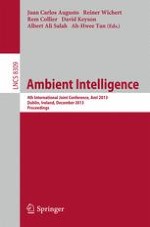This book constitutes the refereed proceedings of the 4th International Joint Conference an Ambient Intelligence, AmI 2013, held in Dublin, Ireland, in December 2013. The 15 revised full papers, 4 papers from the landscape track, 3 papers from the doctoral colloquium and 6 demo and poster papers were carefully reviewed and selected from numerous submissions and are presented with 6 workshop descriptions. The papers cover a variety of multi-disciplinary topics in computer science, human computer interaction, electrical engineering, industrial design, behavioral sciences, distributed devices, ubiquitous and communication technologies, pervasive computing, intelligent user interfaces and artificial intelligence.
